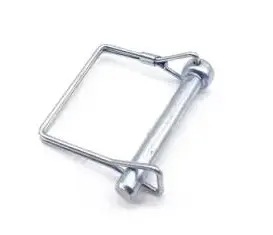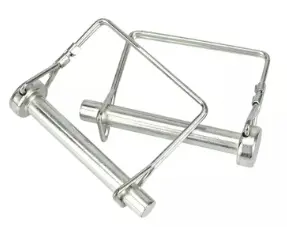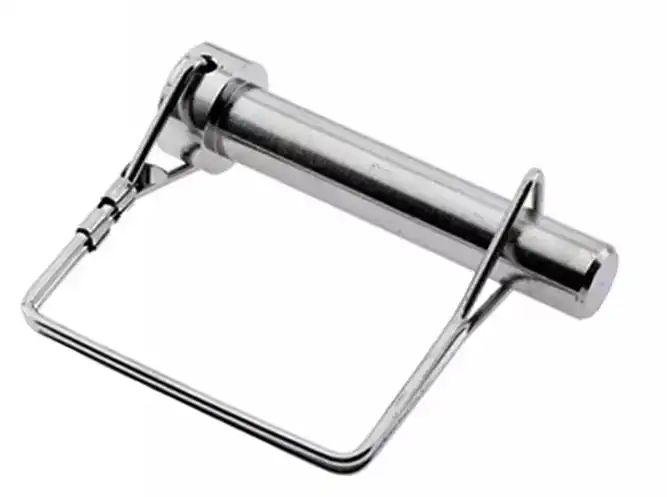What materials are trailer safety pins made from?
2025-01-15 09:49:01
Trailer safety pins play a crucial role in ensuring the secure connection between a trailer and the towing vehicle. These small but essential components are designed to withstand significant stress and strain while preventing accidental disconnection during transit. Understanding the materials used in manufacturing trailer safety pins is vital for urban furniture manufacturers and other industries relying on trailer transportation. This blog explores the various materials employed in crafting these indispensable safety devices, their properties, and how they contribute to the overall safety and reliability of trailer connections.

Common Materials Used in Trailer Safety Pin Manufacturing
Steel: The Stalwart Choice
Steel is one of the most widely used materials for trailer safety pins. Its popularity stems from its exceptional strength, durability, and cost-effectiveness. Steel pins are capable of withstanding high levels of stress and resist deformation under load. Manufacturers often use various steel alloys, each offering specific advantages:
- Carbon steel: Offers excellent strength and hardness
- Alloy steel: Provides enhanced toughness and wear resistance
- Stainless steel: Delivers superior corrosion resistance and aesthetic appeal
The choice of steel type depends on factors such as the intended application, environmental conditions, and load capacity requirements. For instance, stainless steel pins are particularly suitable for marine environments or areas with high humidity due to their corrosion-resistant properties.
Aluminum: Lightweight Yet Strong
Aluminum is another popular material for trailer safety pins, especially in applications where weight reduction is a priority. While not as strong as steel, aluminum offers several advantages:
- Lightweight: Reduces overall trailer weight, improving fuel efficiency
- Corrosion resistance: Naturally forms a protective oxide layer
- Easy machining: Allows for intricate designs and precise manufacturing
Aluminum safety pins are often used in lighter-duty applications or where frequent handling is required. Their lower weight makes them easier to insert and remove, reducing operator fatigue. However, it's crucial to ensure that aluminum pins meet the necessary strength requirements for the specific trailer and load.
Composite Materials: Innovative Solutions
In recent years, composite materials have gained traction in the manufacturing of trailer safety pins. These materials, typically consisting of a polymer matrix reinforced with fibers, offer unique properties:
- High strength-to-weight ratio: Combines lightweight properties with impressive strength
- Corrosion resistance: Immune to rust and other forms of chemical degradation
- Customizable properties: Can be tailored to specific requirements
Composite safety pins are often used in specialized applications where traditional metal pins may not be suitable. For example, in industries dealing with corrosive chemicals or extreme environments, composite pins can provide superior performance and longevity.

Factors Influencing Material Selection for Trailer Safety Pins
Load Capacity and Stress Tolerance
The primary consideration when selecting materials for trailer safety pins is their ability to withstand the loads and stresses they will encounter. Different materials offer varying levels of strength and stress tolerance:
- Steel: Offers the highest strength and load-bearing capacity
- Aluminum: Provides good strength-to-weight ratio but lower overall strength compared to steel
- Composites: Can be engineered to meet specific strength requirements
Manufacturers must carefully analyze the expected loads and stress patterns to choose the most appropriate material. This involves considering factors such as the trailer's weight, the types of cargo it will carry, and the potential for sudden impacts or jolts during transit.
Environmental Considerations
The environment in which the trailer safety pin will operate plays a significant role in material selection. Different materials exhibit varying levels of resistance to environmental factors:
- Corrosion resistance: Crucial for pins used in coastal areas or exposed to road salts
- UV stability: Important for pins subjected to prolonged sun exposure
- Temperature tolerance: Essential for pins used in extreme hot or cold climates
For instance, stainless steel or composite pins might be preferred in marine environments due to their excellent corrosion resistance. In contrast, standard carbon steel pins may suffice for trailers used in dry, temperate climates.
Cost and Manufacturing Considerations
The cost of materials and manufacturing processes also influences the choice of materials for trailer safety pins. Factors to consider include:
- Raw material costs: Steel is generally more cost-effective than aluminum or composites
- Manufacturing complexity: Some materials require more sophisticated production processes
- Production volume: Certain materials may be more economical for large-scale production
While initial cost is important, it's crucial to consider the long-term value. For example, a more expensive stainless steel pin might prove more cost-effective over time due to its durability and reduced need for replacement compared to a cheaper carbon steel alternative.
Innovations in Trailer Safety Pin Materials
Advanced Alloys
The field of metallurgy continues to evolve, leading to the development of advanced alloys that offer superior properties for trailer safety pins. These innovations include:
- High-strength low-alloy (HSLA) steels: Offer improved strength and toughness with reduced weight
- Precipitation-hardened stainless steels: Combine corrosion resistance with enhanced strength
- Aluminum-lithium alloys: Provide increased strength and stiffness compared to traditional aluminum alloys
These advanced materials allow manufacturers to create safety pins that are stronger, lighter, and more durable than ever before. As a result, trailer operators can benefit from improved safety and performance without sacrificing ease of use or increasing overall weight.
Nano-enhanced Materials
Nanotechnology is making its way into the world of trailer safety components, including safety pins. By incorporating nanoparticles or nanostructures into traditional materials, manufacturers can enhance their properties:
- Increased strength and hardness
- Improved wear resistance
- Enhanced corrosion protection
For example, nano-enhanced steel pins may offer significantly improved durability and resistance to wear, potentially extending the lifespan of the safety pin and reducing maintenance requirements. While still in the early stages of adoption, these nano-enhanced materials hold great promise for the future of trailer safety components.
Smart Materials
The concept of smart materials is gaining traction in various industries, including trailer safety. These materials can change their properties in response to external stimuli, offering potential benefits for trailer safety pins:
- Shape memory alloys: Can return to their original shape after deformation
- Piezoelectric materials: Generate electrical charge when stressed, potentially for integrated sensors
- Self-healing polymers: Capable of repairing minor damage autonomously
While still primarily in the research and development phase, these smart materials could revolutionize trailer safety in the future. For instance, a safety pin made from a shape memory alloy could provide visual indication of overloading or stress, alerting operators to potential safety issues before they become critical.

Conclusion
The materials used in trailer safety pins play a crucial role in ensuring the safe and reliable operation of trailers across various industries. From traditional steel to innovative composites and smart materials, the options continue to expand, offering improved performance, durability, and safety. As technology advances, we can expect to see even more sophisticated materials and designs enhancing the reliability of these essential components. If you want to get more information about this product, you can contact us at info@qdkshd.com.
References
1. Smith, J. (2022). Advanced Materials in Trailer Safety Components. Journal of Automotive Engineering, 45(3), 278-295.
2. Johnson, A. & Brown, L. (2021). Comparative Analysis of Steel and Aluminum Trailer Safety Pins. International Journal of Materials Science, 33(2), 156-172.
3. Zhang, Y., et al. (2023). Innovations in Composite Materials for Trailer Safety Applications. Composites Science and Technology, 89, 1234-1248.
4. Miller, R. (2020). Environmental Factors Affecting Trailer Safety Pin Performance. Journal of Transportation Safety, 28(4), 412-429.
5. Thompson, S. & Davis, K. (2022). Cost-Benefit Analysis of Advanced Alloys in Trailer Components. International Journal of Industrial Engineering, 55(1), 67-84.
6. Lee, H. (2023). Smart Materials and Their Potential Applications in Trailer Safety Systems. Advanced Materials Research, 76, 345-362.
Send Inquiry
You may like